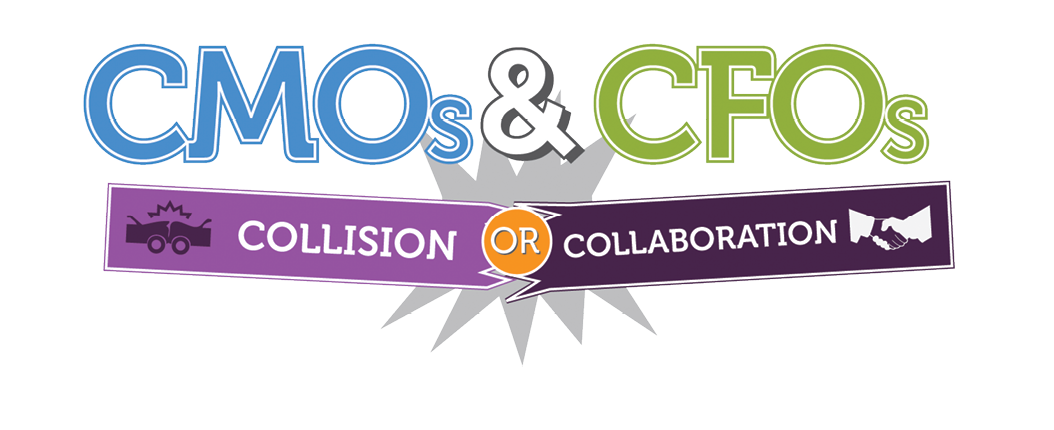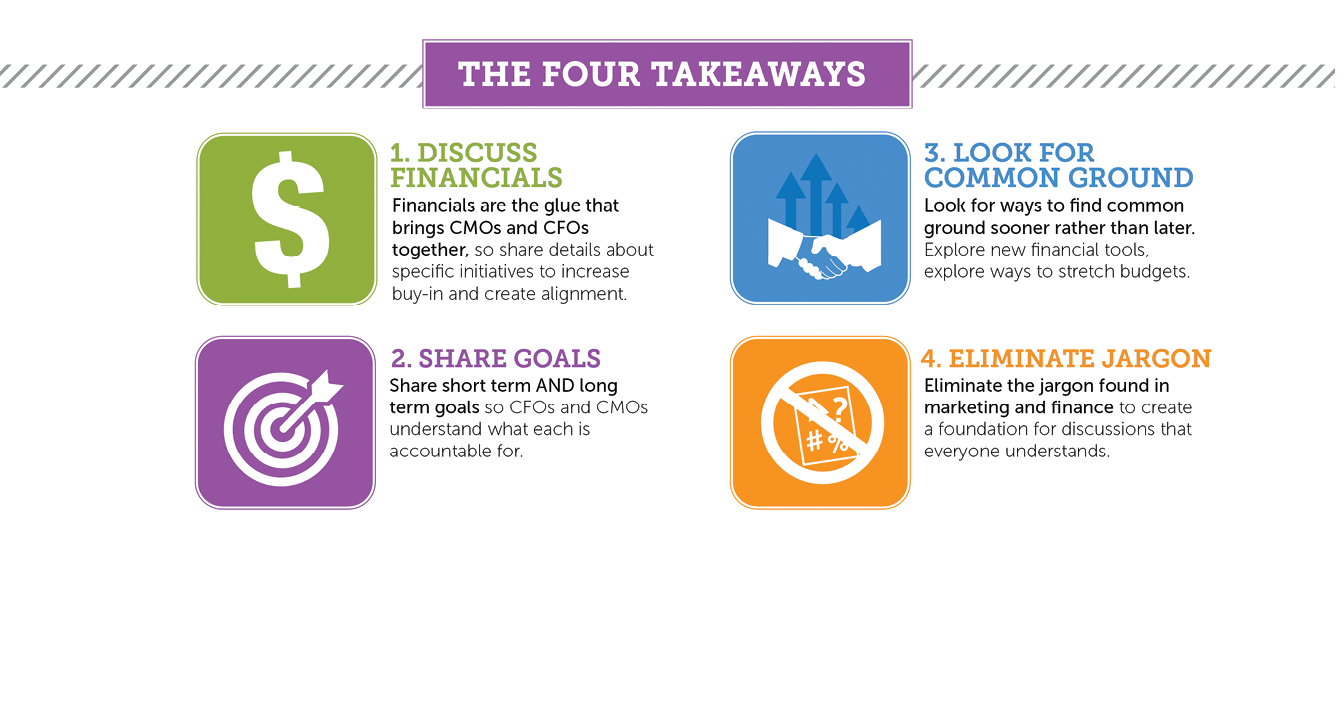


![]()
ONLINE
Measuring the ROI
on C-Suite Alignment
Key Takeaways From Active International’s Latest Survey

It is particularly important for CMOs and CFOs to be aligned. Today’s competitive marketplace is creating a greater need for marketing, positioning and branding strategy than ever before. CMOs face growing scrutiny from an ROI perspective as their campaigns are increasingly being linked to their company’s financial performance and results. This means CMOs and CFOs are working together more now than ever before.
In our business of corporate trade, a central aspect of our job is to deliver creative business solutions that help both CMOs and CFOs drive growth and manage costs. As such, we decided to dig a bit deeper and conduct a survey to better understand how well aligned CMOs and CFOs are. The survey, CMOs & CFOs: Collision or Collaboration, was conducted earlier this year with the help of independent research partner, Market Measurement. We asked 100 CMOs and 100 CFOs about their working relationship with their counterpart. Not only were the survey’s findings compelling, but they shed some light on how CEOs can help these two integral members of their C-suite work together more effectively.
CMOs and CFOs Do Value Alignment, But They Don’t Completely Understand its Impact on Business

A key finding from the survey is that while CMOs and CFOs place great importance upon alignment, they don’t necessarily understand its impact on business performance. In total 77% of CMOs and 76% of CFOs questioned stated that being in sync with their counterpart was either extremely or highly important. When asked about the negative effects of misalignment, however, only 45% of each group said that it has a moderate to negative consequence or worse.
Yet it is imperative that these two C-suite executives see eye to eye. More than 40% of companies that had their marketing and finance teams work in close collaboration performed above expectations, according to a Marketing 2020 survey. Thus, misalignment can have meaningful, long-term impacts on business success. On a granular level, it can hinder employee performance and shade attitudes between teams as well as corrode overall corporate culture. From a high-level perspective, it can hamper sales optimization, deter top talent from joining companies and drive off potential business partners or clients.
CMOs and CFOs Rank Their Alignment on Key Issues Differently
While the majority of CMOs and CFOs agree that collaborating with each other is essential, the survey revealed that they may be more misaligned than they realize. When asked on which issue they are most aligned with their counterpart, CMOs and CFOs both said they most agree on the overall strategic direction of the business.
That is where agreement between the two parties ends. CMOs went on to rank business development objectives the second and marketing and advertising objectives and budget the third issue on which they most align with CFOs. On the other hand, CFOs ranked financial priorities second and business development objectives third. Thus, while they agree that being in sync is vital, their perceptions of how they currently align do not match.
It is important to remember that different mindsets and approaches can often breed innovative and dynamic business solutions. As long as differences in opinion do not lead to a power struggle but are handled constructively, richer, more thoughtful strategies can result. This is accomplished more easily when CMOs and CFOs are aligned on key issues.
How CEOs can Help Bridge the Gap

At the helm of their company’s leadership, CEOs are well positioned to encourage effective teamwork between CMOs and CFOs. Here are some ways they can help:
1. They can support open and active communication between both counterparts. While CMOs and CFOs both touch their company’s finances, CMOs impact the finances, while CFOs manage them. To eliminate “grey zones” in their dialogues, CEOs can encourage them to share more details around initiatives on a regular basis to boost understanding and buy-in.
2. They can help CMOs and CFOs find common ground. As mentioned before, these C-suite executives are working together more closely now than ever before, so the time to lay the foundation for collaboration is now. Working together to leverage new financial tools and stretch budgets is beneficial to both executive and company performance. Incorporating business models, such as corporate trade, which can appeal to marketing-driven CMOs and numbers-conscious CFOs, can lead companies to success.
3. They can emphasize a commitment to long-term strategy. It can be challenging when CFOs have to submit financial reports on a quarterly basis, while CMOs’ marketing campaigns can take six months to a year to impact ROI. CEOs can help by encouraging CMOs to identify shorter-term marketing successes for the CFO to include in reports that highlight the connection between marketing and ROI in a more tangible way.
4. They can cultivate a common language between CMOs and CFOs. Both parties often use different jargon, and this can detract from their working relationship. Incorporating terms that are relevant to both counterparts, such as shareholder value, market share and competitor advantage, can establish a neutral platform for conversation that is based more on the overall direction of the company, and less on individual departments.
The most successful companies are the ones whose employees share a common vision and set of objectives. Since effective business strategy often comes from the top, it is imperative that CEOs ensure their C-suite partners are aligned and working together toward a common goal. By fostering an atmosphere of communication and collaboration between CMOs and CFOs, CEOs can drive their companies with more creative and insightful business strategy to improve performance and add to the bottom line.
It is essential for companies to leverage the talent and expertise of their employees if they want to succeed. CEOs can help drive this momentum by making sure their employees, particularly their C-suite partners, are aligned. By supporting close communication and collaboration among their leaders, CEOs can better position their companies to stand out from the competition and succeed.
EDITORS’ NOTE
Alan Elkin cofounded Active International with Arthur Wagner more than 30 years ago. In recognition of Active’s entrepreneurial global accomplishments, he was awarded the Entrepreneur of The Year award by Ernst & Young and has received the Averill Harriman International Trade Award and the British American Business Inc. (BABi) Award. Active Cares, which he created with Arthur Wagner in 1997, has provided contributions to more than 600 charities. In 2005, Elkin received the Medal of Honor from Good Samaritan Hospital for his work with Active Cares. In 2006, the company acquired the naming rights for the Active International Cardiovascular Institute at Good Samaritan Hospital. Elkin received his B.A. from Brooklyn College and is a native of New York. He began his career at Kaiser Broadcasting, the predecessor to Katz Media Group.
COMPANY BRIEF
Active International (activeinternational.com) consults with the Fortune 1000 on ways to optimize their enterprise assets, typically excess and underperforming inventory, real estate, and capital equipment. As the global leader in corporate trade, Active has successfully helped many of the world’s leading brands recover value, reduce costs, and increase market share. Providing a dynamic financial tool, Active has helped its clients improve their business performance, delivering $1.5 billion in economic benefit since 1984. Active International is based in New York and has offices in 14 countries.